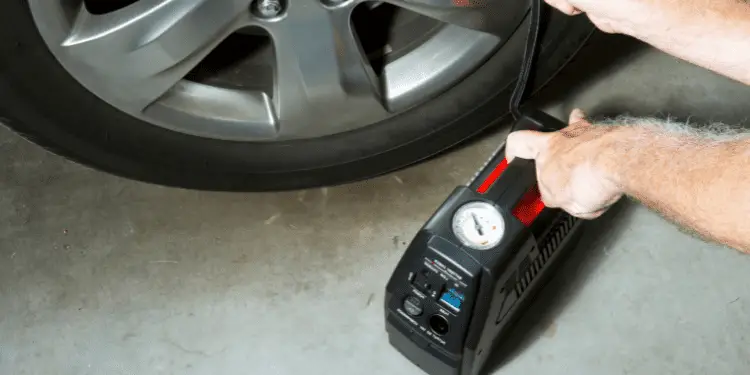When a car feels like sliding on ice, it can gradually happen or come on suddenly.
Below we will examine the causes of why your car feels like it is ‘floating’ along with remedies and potential dangers.
Briefly, either one of your tires has lower tire pressure than the others, a wheel alignment, steering, or suspension problem.
Let’s look into these in more detail:
Tire Pressure
Tire Underinflation
When one tire has pressure even 5 to 10 PSI lower than it should be, it can dramatically affect how the car handles.
Often this low PSI difference isn’t noticeable to the naked eye, so you’ll need to inspect this using a tire pressure gauge.
The good news is most gas stations or car shops will let you do this for free. Some, though, are starting to charge for this.
Low tire pressure is the best scenario because it is extremely cheap to put right. So always start there if you feel that your car is sliding.
A word of caution is that if your car has been feeling this way for some time and one tire has low pressure, it may have worn unevenly and needs to be replaced.
Pay particular attention to the tread inside and outside of the tire. Also, look for sidewall wear, as it may have been in contact with the pavement if the pressure was low.
Any wear on the sidewall means you should change your tire as soon as possible. A weakened tire wall structure is dangerous.
Tire Overinflation
It can be tempting to overinflate your tires by a couple of PSI. I’ve done this, thinking it will save me from returning and getting more air in my tires soon.
A friend of mine put an extra five psi in his tires but soon realized that it had changed his car’s feel and handling.
He described his car as feeling floaty, and this was because the overinflation had caused less tire tread to be in contact with the road.
A great indicator of overall inflated tires is that the center part of the tire is the only part in contact with the road, so look for additional wear here.

Suspension
Ball rods, bushings, shocks/struts, and tie rods are parts of the suspension that wear out over time.
There is no routine maintenance for these suspension parts, and normally any defects are picked up during routine inspection or are only noticed when the steering or feel of the car changes and feels like it’s slipping.
Bushes
Bushings are the most likely cause if you are not hearing knocking noises. Knocking noises would indicate ball rod joints are bad.
Bushings, however, are rubber parts that restrict the movement of the suspension joints and keep the car feeling tight and precise.
Suspension bushes are cheap and don’t require much expert knowledge to replace them. Being made of rubber, they are perishable, and due to their location low down close to the pavement, they are affected by rain, ice, and dirt, making them vulnerable.
Most cars have either 8 or 16 suspension bushings. Each car has two bushes per control arm, but some cars have one arm per wheel while others have two.
Control arm bushings – there are many other bushes, including steering and engine mount bushes – normally last around 50000 miles before needing to be replaced. This period decreases if you drive in more adverse weather conditions and increase if you drive in dry arid conditions where the car is subjected to less corrosion and dirt.
If you have money available, you may want to consider changing all the bushes that look vulnerable rather than the ones that are perished.
It will save you time and money in the future because if one bush has failed, you can guarantee that others will be feeling fairly soon after
Once you replace the bushes, your car will feel tighter on the road, and your steering should feel more precise even though the parts replaced are not steering components.
Shocks or Struts
Your car’s shocks or struts help cushion your ride as you go over bumps and potholes. Sliding on ice – in the summer – is a common feeling when one or more of them go bad.
Your car can’t drive precisely if the strut or shock hasn’t quickly done its job of restabilizing the car after a bump in the road.
This is an easy check that doesn’t need you to get under the car. Press down firmly on each car corner, step back and watch.
Your car should bounce no more than twice before settling at the same height as the other corners of the car. If it bounces more than this, it is a surefire bat that the shock or struts on that corner need replacing.
An oil-type leak under the car by a wheel is a sure sign that your shock is blown. Shocks contain hydraulic fluid, which stops the shock from doing this job effectively when this leaks.
Ball Joints
Ball joints are categorized into load-bearing and non-load-bearing joints. Load bearing joints are the ones that support the car’s weight and are more prone to failing quicker than non load bearing joints.
If your car feels like it is skidding on ice, it is likely because the weight distribution is incorrect on your car, and a bad ball joint can cause this.
Most cars have two ball joints per wheel, with the lower being connected to the steering knuckle. This is the one that can give off vague steering symptoms and should be checked first.
More modern cars use the McPherson system, which only has one ball joint per wheel and a strut replacing the second ball joint.
If your car has a sway bar link – they run the width of your car – and the bushings have failed, it can cause misalignment by a couple of mm and make all the difference in the feel of your car.
Wheel Alignment
Even if your wheels have been aligned recently, any changes in the ball joint or the bush’s condition can alter the alignment.
As mentioned, your ball joints and bushes are meant to provide a taut and precise driving experience, but when they become loose or worn, they can interfere with the fine balance of your wheels.
Many drivers will align their wheels rather than inspect the cause of the misalignment.
The difference between alignment and balancing
This is a false economy as its effect will be minimal, and you will soon find you are experiencing the same issues as you were before.
Far better to dig a little deeper and thoroughly inspect the suspension components before committing to a wheel alignment.
Steering Part Failure
Tie Rod Ends
Tie rod ends connect your wheels to the steering rack and sit above the control arm. Without tie rod ends, your car would not steer.
It stands to reason that if they are defective, you will have issues with your car’s handling and stability as the wheels quickly become misaligned. You may also hear a clicking or clunking noise as you turn the wheel.
Conclusion
There are three main areas to inspect when you feel your car is floaty or like it’s driving on ice.
- Incorrect Tire Pressure – Over and underinflation
- Suspension – Bushes, Shocks, or Ball joints
- Steering – Tie Rod Ends







![Car Wobbles At Low Speeds - [Troubleshooter Guide] inflating-tire-on-balancing-machine](https://carzaza.com/wp-content/uploads/2023/12/inflating-tire-on-balancing-machine-300x150.png)





